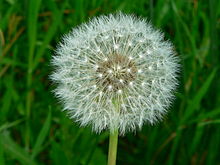Here is the enthusiastic description by a New Yorker of the first appearance of a certain plant in Central Park long ago. “The park is filled with blessed dandelions in such beautiful profusion as we have never seen before, making the lawns in places, like green lakes reflecting a heaven sown with stars.”
Today, homeowners trying to grow the perfect lawn despise the dandelion. Millions of dollars are spent on herbicides to control its spread.
The word dandelion comes from the French “dent de lion” which refers to the teeth of the leaves. They do look like the teeth of a lion.
A few years, I decided to try an experiment in our back garden (which a neighbour refers to as “my laboratory”). I allowed all of the dandelions which appeared to “have their way” and to grow as they wished with no interference from me. Big mistake! For the next five years in spring, I went out each morning and pulled about 100 from the roots just to keep from being completely overwhelmed with yellow.
Taraxacum officinale as it is officially called, does have its uses. The young leaves are rich in vitamins and minerals and can be used in salads. Wine can be made from the fermented flowers and the roots can be collected in fall, roasted and used as a coffee substitute.
And what fun for kids when the plant has gone to seed. All of those little floating parachutes. Heck, I still blow them around myself!
Dandelion was originally a Eurasian species but it has become naturalized in most habitats except the wettest.
In Québec, the plant has a very evocative name. “Pisse-en-lit”
“to pee in your bed”


If you get rid of your lawn you’ll also get rid of the dandelions
It’s also called pissenlit in France (not just Québec). As a salad it’s similar to arugula if you pick it in early spring. Later it gets very bitter.